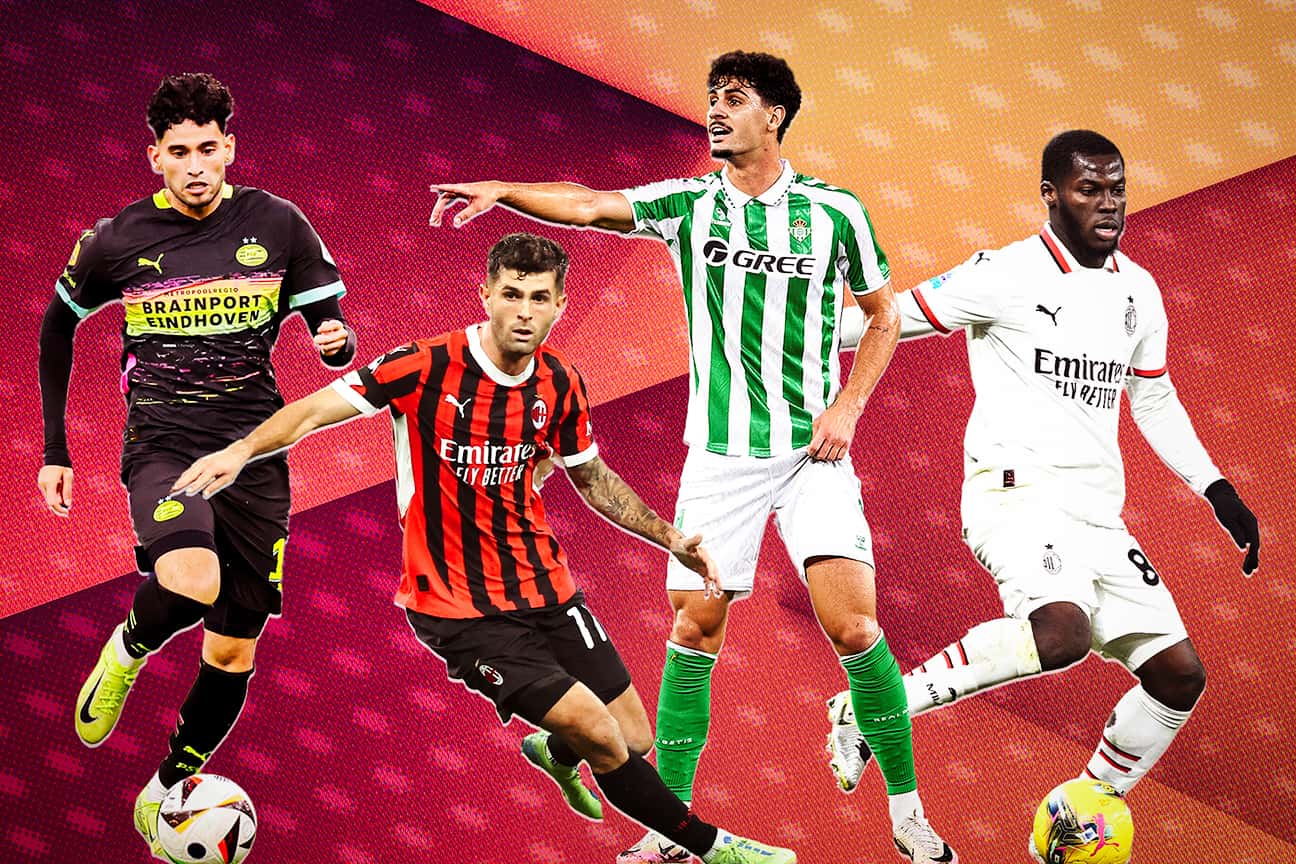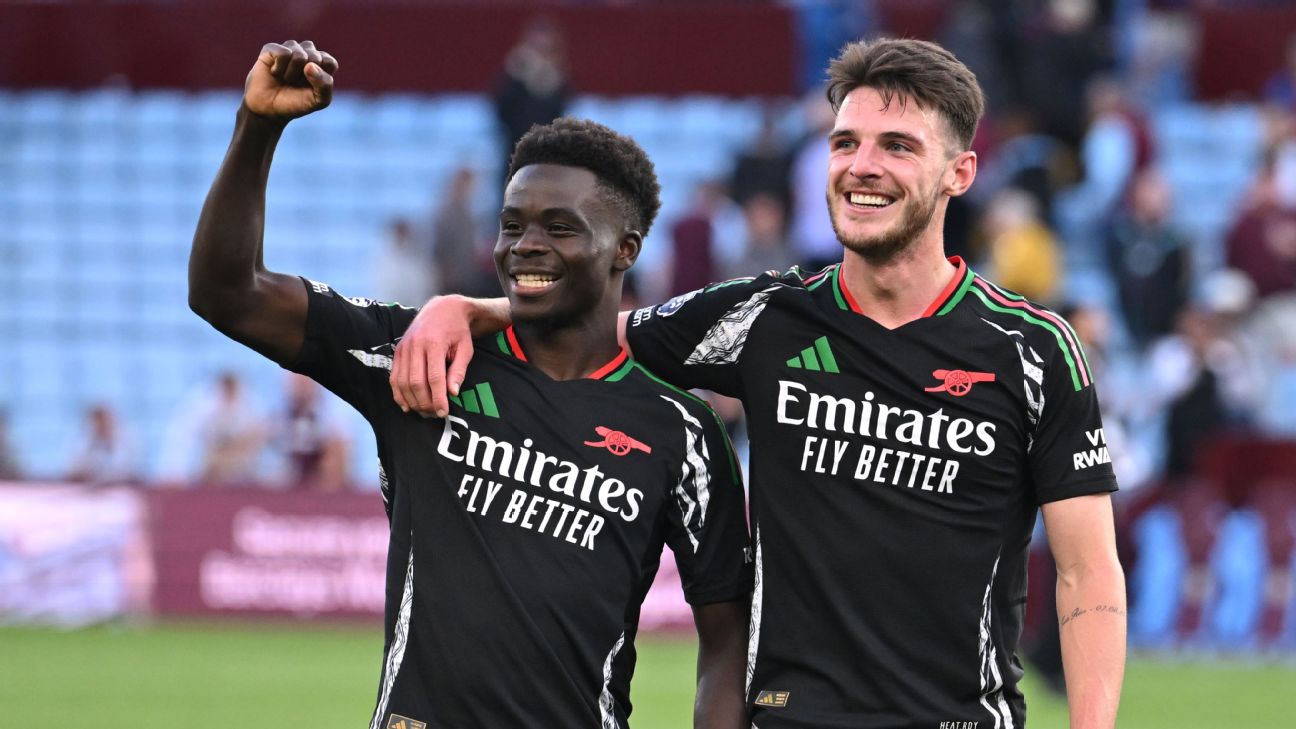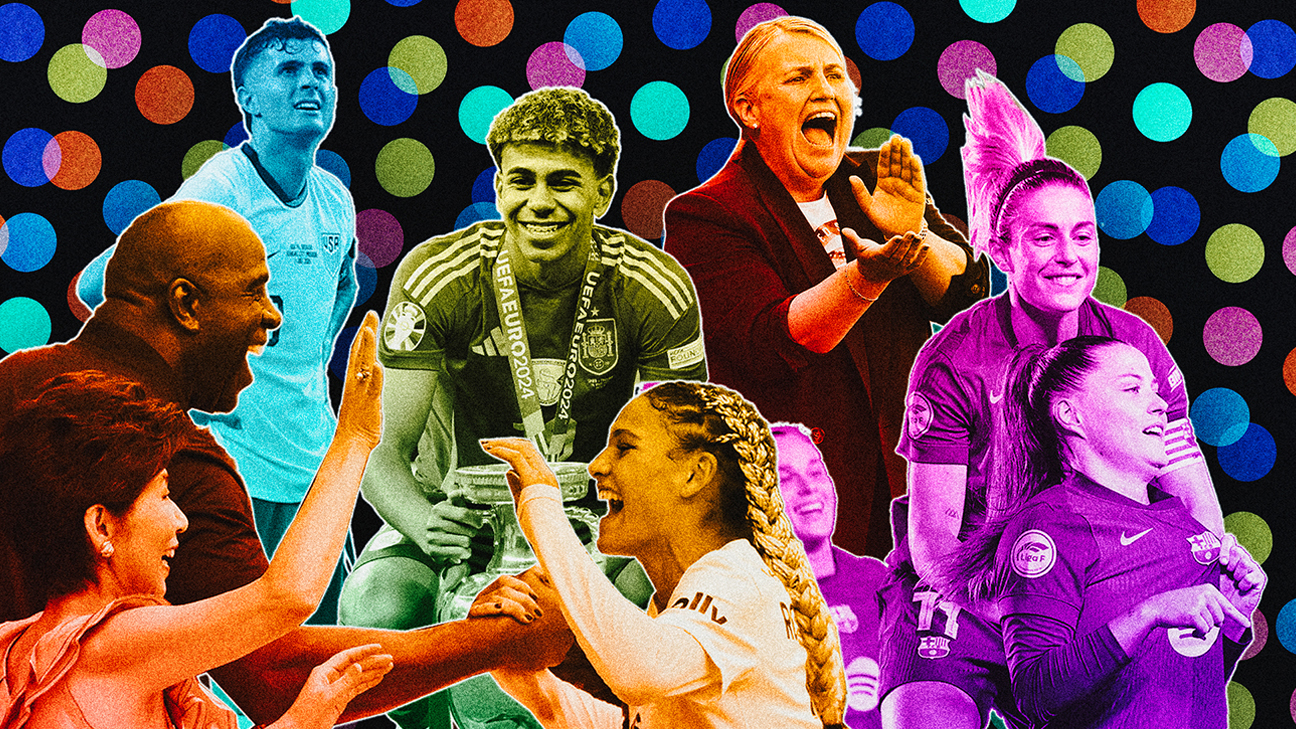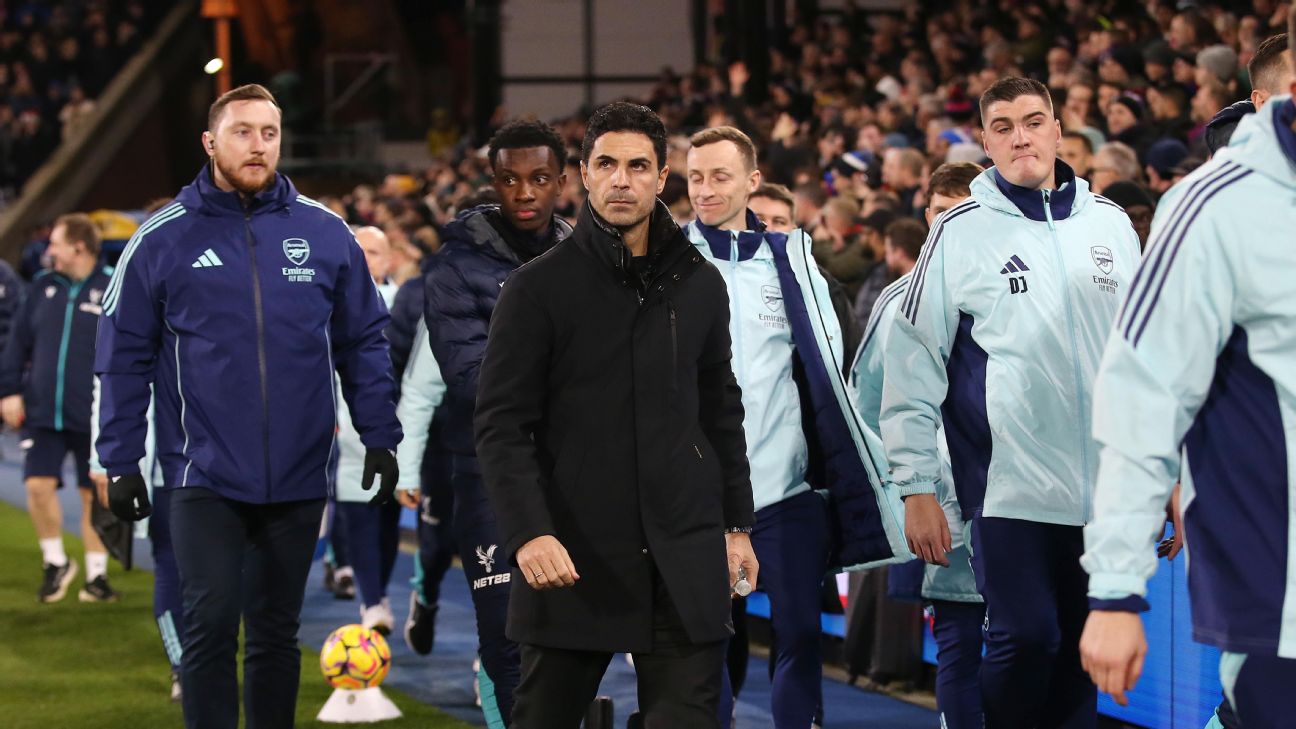It has been a year. Yep, that’s it. Just “a year.” A good year or a bad year for the U.S. men’s national team? Well …
The USMNT’s last competitive tournament before it co-hosts the 2026 World Cup was a complete disaster. The Americans were eliminated from the Copa América before the knockout rounds, and coach Gregg Berhalter was fired soon afterward.
But then they replaced Berhalter with arguably the best candidate available in former Chelsea, Paris Saint-Germain and Tottenham manager Mauricio Pochettino. If it took a terrible tournament to get the U.S. Soccer Federation to hire one of the best coaches in the world, then maybe it was actually a good year? I don’t know.
What I do know, though, is that this team is going to go only as far as the players take it — no matter who is the coach. With the year wrapping up, we’re breaking out the final edition of the USMNT Player Performance Index for 2024. We’ve ranked everyone in the player pool based on their performance at the club level, and then the PPI cuts it down to a top 50.
Who is missing? And how do we rank the USMNT player pool?
When we did this season’s first edition of the rankings in October, there wasn’t a ton of data to work with. First, there had been just over a month of matches. And second, the summer of international tournaments meant a bunch of Americans had arrived late to preseason with their clubs and played only sparingly over the first few weeks of the new season.
So, we anchored the rankings on each player’s Transfermarkt value — a crowd-sourced valuation that isn’t a perfect representation of player quality but is close enough. That made up 60% of the rating. Then 30% went to the quality of the player’s team (as determined by Opta’s global power rankings, which rate every professional team in the world) and 10% went to the percentage of minutes he had played for said team in league play.
Well, now we’re far enough into the season that we can flip things around. We’re giving 75% of the rating to the quality of that player’s team, 20% to the share of available minutes he has played and 5% to his Transfermarkt value. As the season goes on, we’ll drop the transfer value input and increase the importance of minutes played.
In short, we’re awarding players for playing well enough to get identified by better teams, and then we’re adjusting that based on how much they’re actually playing. You can’t provide any value if you’re not playing, but it’s also harder to get playing time when you’re on a better team. This formula takes it all into account.
Before we get to the rankings, let’s quickly touch on who missed the cut.
From Pochettino’s most recent roster, three of the four goalkeepers missed the top 50. Concerningly, the first-string and fourth-string keepers — Crystal Palace’s Matt Turner and Barcelona’s Diego Kochen — haven’t played a single league minute this year. (Kochen has nothing to worry about. He’s 18.) And while Zack Steffen was the starter for the Colorado Rapids this past season, the Rapids simply weren’t very good. See: a plus-1 goal differential in the regular season.
Among defenders, both Miles Robinson and Tim Ream fell outside the top 50. Ream only played nine matches for Charlotte this season, while Robinson would’ve made the list had he played a higher share than the 72% of minutes he played for FC Cincinnati. All of the midfielders from the last roster made the cut, and the only forward to miss out was Brandon Vázquez, who still hasn’t locked down a starting role with Monterrey.
All right, let’s get to the USMNT Player Performance Index — we’ve included how each player’s ranking has changed since our previous edition.

![]()
1. Antonee Robinson, left-back, Fulham (▲ 2 spots)
We have a new No. 1!
Now, we’re not saying that Robinson is better than Christian Pulisic, but this ranking reflects two things: (1) Robinson has played every single Premier League minute for Fulham so far this season, and (2) Fulham are pretty good!
Robinson has continued to be one of the most active and disruptive defenders in the Premier League. He also does a little bit of everything in attack: He passes forward, carries forward, provides an outlet and creates chances for his teammates. The guy is simply one of the better full-backs in the Premier League, and he’s the most reliable player in the entire USMNT pool.
![]()
2. Christian Pulisic, right-winger, AC Milan (▼ 1)
Pulisic had maybe the best season of his career last year, and he has been even better this season. Most notably, he has attempted seven through balls already:
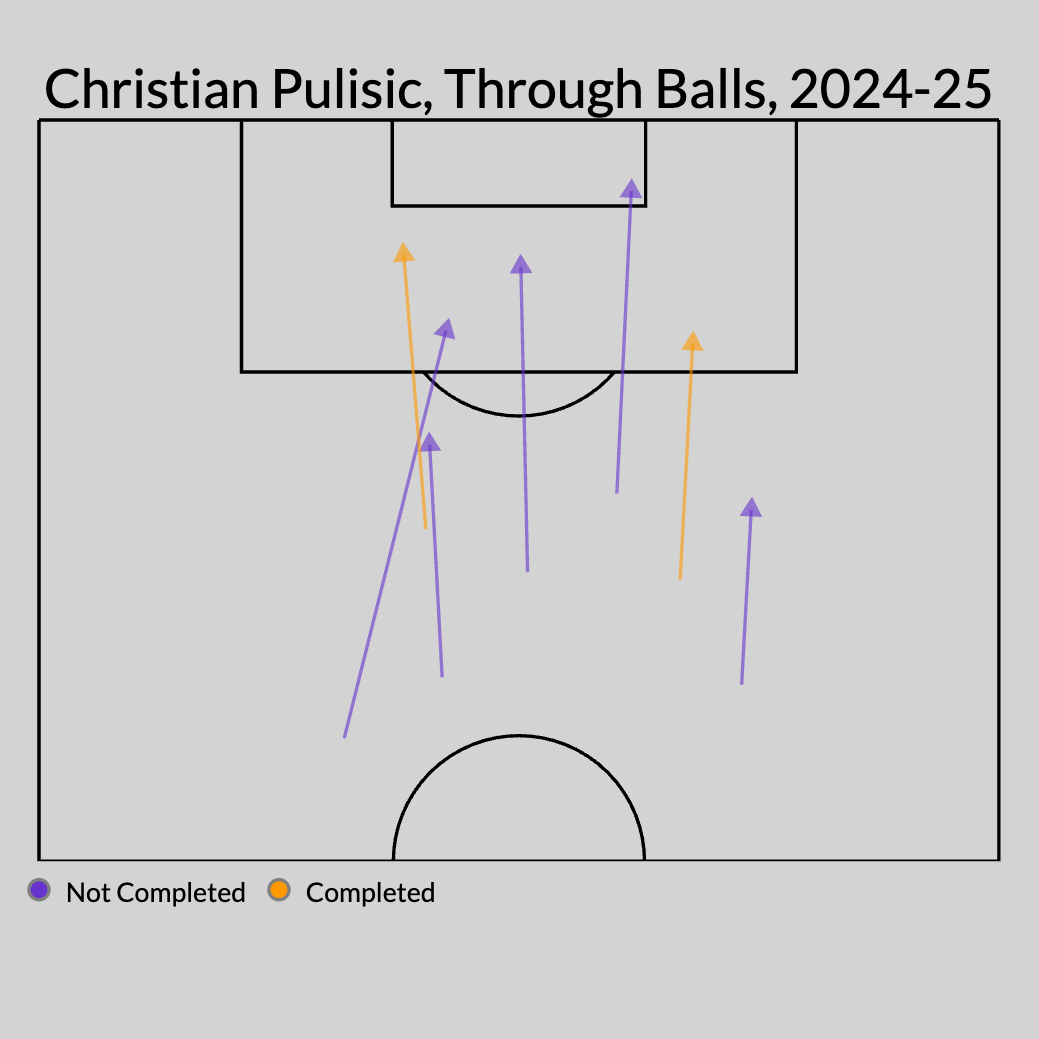
Who cares? Well, he had attempted seven through balls in the previous four seasons — combined. Pulisic has become a more prolific attacker under new manager Paulo Fonseca by frequently playing like a top-of-the-box playmaker. Milan are only in seventh, but they have the fourth-best expected-goal differential in the league, so if the results start to better align with performances, Pulisic should rise back up to No. 1.
That is, if he can stay healthy. Despite opportunistic social-media posts blaring “PULISIC OUT FOR THE YEAR,” his torn calf might not actually keep him out of much match time. Milan have only three more Serie A games in December, and then they get a domestic-play break until Jan. 11.
![]()
3. Malik Tillman, attacking midfielder, PSV (▲ 3)
PSV are annihilating the Eredivisie once again: 56 goals for, 12 against … in 15 games! That’s a plus-44 goal differential. No one else in the league is even at plus-20.
Last season, Tillman was a super-sub for the best team in the Netherlands. This season, he has played 81% of the minutes. I find it really hard to judge attackers in the Eredivisie. There have been countless guys who put up Messi-like numbers only to flop once they moved to more physical, less wide-open leagues. But perhaps Tillman’s Champions League performances provide a better window into what he might do in a Big Five league.
Despite becoming the first USMNT-er to score a brace in the Champions League a few weeks ago, the big difference in Tillman’s performance in Europe, compared with the Netherlands, is that he’s barely getting any shots. And when he does, they’re extremely low-quality attempts. Outside of that, he has maintained a high level of defensive work, creativity and progressive passing in the Champions League. Just based on this season, his top comparison according to FBref’s similar-player tool is, uh, Jude Bellingham.
Yeah, that’s enough to earn a look from a richer club this summer.
![]()
4. Joe Scally, right-back, Borussia Monchengladbach (▲ 9)
Yeah … so … here’s a chart:
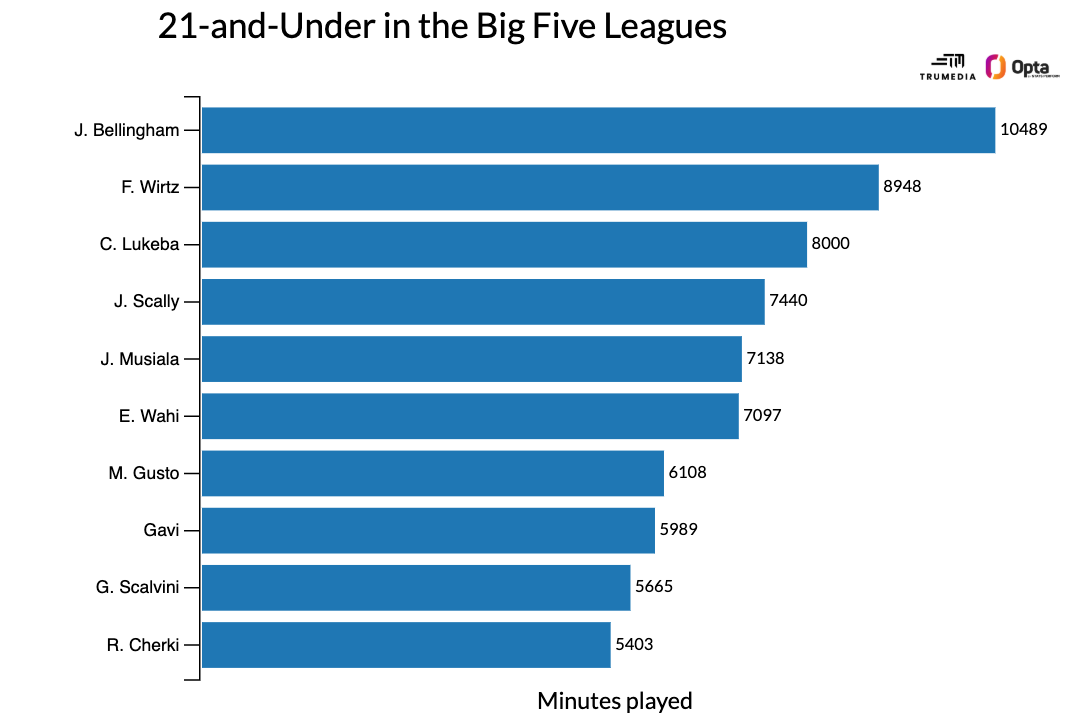
Among all players who are currently 21 or younger, Joe Scally has played more career domestic minutes than everyone other than one of the best French center-back prospects, the best young attacking midfielder in the world and a guy who finished third in Ballon d’Or voting.
![]()
5. Mark McKenzie, center-back, Toulouse (▲ 17)
It’s hard to think of anyone who has improved his standing within the USMNT this year more than McKenzie. He moved to Toulouse over the summer, and he has become a play-every-game starter for a team that has allowed the third-fewest expected goals in Ligue 1. And after not seeing a single minute of game time under Berhalter at the Copa America, he played every minute of both Nations League matches under Pochettino.
I don’t think anyone would’ve said this a few months ago, but it’s hard to argue with it now: McKenzie seems like the most likely center-back starter for the USMNT at the 2026 World Cup.
![]()
6. Brenden Aaronson, midfielder, Leeds United (▲ 9)
Turns out it’s a lot easier to play in the Championship than the Premier League. It’s only December, and Aaronson has already attempted more shots for Leeds this season than he did in the doomed-to-relegation 2022-23 campaign.
How much of that is due to league quality? And how much of it is that Aaronson just turned 24 and so is only now entering his prime years? It’s likely more of the former, but at least some of the latter. Leeds are torching the Championship, and Aaronson has played more minutes than anyone who isn’t a defender or a goalkeeper.
![]()
7. Timothy Weah, winger, Juventus (▲ 9)
Thiago Motta seems like a big fan of Weah’s versatility, and his recent preference for the American over some of the club’s more exciting wing options speaks to his desire to create a more low-variance environment.
In Serie A, Juventus have won six matches, lost none … and drawn nine this season. They’ve allowed the second-fewest expected goals of any team in Europe’s Big Five leagues, they complete a higher percentage of passes than all but four other teams, and yet they attempt only 12.5 shots per game — fewer than 43 other teams.
Weah’s game fits that approach, and if recent matches are any indication, his still-less-than-50% minutes share is only going to grow from here on out.
![]()
8. Paxten Aaronson, midfielder, Utrecht (★ new)
Congrats to the Aaronson brothers — the first siblings to both make it into the top 10 of the USMNT PPI. Your commemorative lollipops are in the mail.
The younger Aaronson has played nearly 90% of the minutes for the second-place team in the Eredivisie. Now, I don’t expect Utrecht to keep this up; they have the sixth-best goal differential in the league. But this is still a step up in quality from last season, when he was on loan with Vitesse, who were relegated from the Eredivisie and are currently in last place in the second division.
Eintracht Frankfurt signed Aaronson to an extension over the summer. Could another half-season of starter minutes as a 21-year-old for one of the better teams in the Netherlands be enough for his parent club to bring him into the fold next season?
![]()
9. Richy Ledezma, fullback, PSV Eindhoven (★ new)
Paging Pochettino …
After joining the Dutch club back in 2019 and suffering a number of serious injuries, the 24-year-old Ledezma has finally become a contributor to PSV’s first team. Ironically enough, Ledezma’s path to playing time was opened up by Sergino Dest’s torn ACL. We’ve reached a point where there are so many Americans in Europe that an injury to one can directly affect the livelihood of another.
He has played only about half of the minutes in the league so far, but PSV are so dominant that they’re able to do a ton of squad rotation. Ledezma still hasn’t been called up by the new USMNT manager, but I can’t imagine that’s going to last long.
![]()
10. Cameron Carter-Vickers, center-back, Celtic (▼ 1)
If you’re going to score an own goal, you better make sure it’s a no-look own goal:
A shocking error from Cameron Carter-Vickers gives Club Brugge the lead 😳 pic.twitter.com/ZH7Wq555Om
— CBS Sports Golazo ⚽️ (@CBSSportsGolazo) November 27, 2024
When healthy, Carter-Vickers continues to be one of the first names on the team sheet for Celtic. And per Opta, they rate one spot below Fulham and one spot ahead of Roma. They’ve scored 44 goals in Scotland and allowed a barely believable four. And unlike in previous years, they’ve held their own in the Champions League, too: scoring 10 and conceding 10, nine of which were credited to the other team.
![]()
11. Ricardo Pepi, striker, PSV (▲ 6)
To better understand the PSV Effect, consider this: Sporting Lisbon’s Viktor Gyokeres is arguably the hottest striker on the transfer market. Even at the already-midprime age of 26, the soccer world thinks he’s going to be worth around €70 million whenever he inevitably leaves Portugal.
According to FBref’s similar-player algorithm, the most statistically similar player to Gyokeres outside of Europe’s Big Five leagues is … Ricardo Pepi.
So, are PSV so good because Pepi is Gyokeres and Tillman is Jude Bellingham? Or is PSV’s squad as a whole so good that it makes Pepi’s and Tillman’s numbers look like those of superstars? Given how good the team was last year, with both of them playing fewer minutes, it’s almost certainly the latter. But both players also deserve some credit for the team maintaining its excellence while both began to play more often.
Oh yeah: Pepi is PSV’s leading goal scorer. With an increased minutes load, he has continued to score goals at an absurd per-minute rate. And he’s still only 21. My guess is that he becomes something like a first-choice starter in the second half of this season or next season. And if he can still keep it up then? Someone’s going to make a big-money bet on him.
![]()
12. Auston Trusty, center-back, Celtic (▲ 20)
![]()
13. Yunus Musah, central midfielder, AC Milan (▼ 6)
And the wait continues for Musah to go from prospect to reliable pro. Despite being a year older and playing under a new coach, he has the exact same minutes share (43%) as last season.
![]()
14. Weston McKennie, central midfielder, Juventus (▼ 10)
He has been in and out of the lineup — partially due to injury and partially due to Motta’s preference for other players. McKennie’s penchant for off-ball runs and just generally “more chaos” doesn’t seem like it would sit well with Motta’s desire for utter and total control. But I’ve also thought that pretty much every other Juventus manager would end up disliking McKennie, and he pretty much always eventually has become a first-choice player.
![]()
15. Folarin Balogun, striker, Monaco (▼ 13)
Despite being injured for a large chunk of the season, he still has generated the second-most expected goals for the team with the second-best goal difference and expected-goal difference in Ligue 1. If he even just starts to convert his chances at a league-average rate, he’s going to put up an elite goal-scoring season at some point.
![]()
16. George Bello, fullback, LASK (★ new)
![]()
17. Marlon Fossey, fullback, Westerlo (★ new)
![]()
18. Bryan Reynolds, right-back, Westerlo (▲ 24)
![]()
19. Julian Green, midfielder, Greuther Fürth (★ new)
That fact that he’s 29 has me feeling incredibly old and incredibly young — at the exact same time.
![]()
20. Gianluca Busio, midfielder, Venezia (▲ 7)
![]()
21. Aidan Morris, forward, Middlesbrough (★ new)
![]()
22. Lennard Maloney, defensive midfielder, Heidenheim (▲ 2)
![]()
23. Patrick Schulte, goalkeeper, Columbus Crew SC (▲ 2)
A quick note: Opta rates all of the teams in MLS way too highly for my liking, so I added a minor discount to the ratings of all the MLS sides in the model. Given how most USMNT squads have only a handful of (if any) MLS players on the roster, it seems right that the highest-rated MLS player comes in on the fringes of the top 20.
At 22, Schulte was the starting goalkeeper for what many people considered to be the best team in MLS before the playoffs started. It seems as if Pochettino will keep selecting Turner even though he has barely played any professional soccer over the past year. If Turner’s situation doesn’t change and if the Argentine coach does eventually decide that he wants a keeper who is getting actual playing time, Schulte will likely be first in line.
![]()
24. Alejandro Zendejas, winger, Club America (★ new)
![]()
25. Johnny Cardoso, defensive midfielder, Real Betis (▼ 20)
He started the first leg of the Concacaf Nations League series against Jamaica in November but then came off after 20 minutes with a hamstring injury. He hasn’t played for Betis since.
![]()
26. Drake Callender, goalkeeper, Inter Miami (▲ 9)
![]()
27. Jackson Ragen, center-back, Seattle Sounders (▲ 18)
![]()
28. Jordan Pefok, forward, Union Berlin (▲ 1)
![]()
29. Cristian Roldan, central midfielder, Seattle Sounders (▼ 6)
![]()
30. Josh Sargent, striker, Norwich City (▼ 29)
The most polarizing player in my near year of doing these rankings had surgery on his groin a month ago and is not expected back until 2025.
![]()
31. Jordan Morris, left-winger, Seattle Sounders (▼ 11)
Jordan Morris’ sharp finish earns Seattle a 2-1 win at LAFC as the Sounders advance in the MLS Western Conference playoffs.
![]()
32. Rokas Pukstas, attacking midfielder, Hajduk Split (▼ 14)
![]()
33. Tyler Adams, defensive midfielder, AFC Bournemouth (▼ 18)
What’s that? You can’t hear me? I’m whispering because I don’t want to jinx anything. Lean your head in a bit. No, more. Even more. Yeah, that’s better. Still can’t hear? Hmm, OK. You know what? Here is an earpiece used only by the National Geological Survey so scientists can hear the sound waves produced by the most minor cracks in the San Andreas fault. It provides advance warning for any potential earthquakes.
Yeah, just stick it in there like a normal earbud. Good, OK? Now I’ll say it: Tyler Adams has started four Premier League games in a row.
![]()
34. Kahveh Zahiroleslam, forward, Sint-Truidense (★ new)
![]()
35. Chris Richards, center-back, Crystal Palace (▼ 23)
He injured a hamstring back in September and has played only 11 minutes since. One of the downsides to more and more Americans playing for top clubs in Europe: more and more Americans get eaten up by the absurdly grueling professional soccer calendar.
![]()
36. Haji Wright, left-winger, Coventry City (▼ 14)
![]()
37. Brooks Lennon, right-back, Atlanta United (▲ 10)
![]()
38. Maximilian Dietz, center-back, Greuther Fürth (★ new)
![]()
39. Timothy Tillman, central midfielder, LAFC (▲ 7)
![]()
40. Cade Cowell, forward, Guadalajara (★ new)
He’s only 21, and he has been pretty good in limited minutes in Liga MX. The problems, for the purposes of these rankings: those limited minutes and Chivas sitting in ninth place.
![]()
41. Aaron Long, center-back, LAFC (★ new)
![]()
42. Tanner Tessmann, midfielder, Lyon (▼ 8)
Tessman started both Jamaica matches but has played only 21 total league minutes for Lyon since returning to France. His size-skill combo makes him the most intriguing of all the young American midfielders in Europe. Can he find more consistent playing time in the second half of the season?
![]()
43. Sergiño Dest, right-back, PSV (▼ 27)
Even with zero minutes played, PSV’s overall quality and his transfer value were still enough for Dest to make the top 50.
![]()
44. Darlington Nagbe, central midfield, Columbus Crew SC (▲ 6)
![]()
45. Marky Delgado, midfielder, LA Galaxy (★ new)
![]()
46. Roman Celentano, goalkeeper, FC Cincinnati (★ new)
![]()
47. Julian Gressel, right-winger, Inter Miami (▼ 9)
![]()
48. Giovanni Reyna, midfielder, Borussia Dortmund (▼ 38)
Somehow, it has been even worse than last year, when he played 9.2% of the minutes for Dortmund and 6.9% of the minutes while on loan to Nottingham Forest. This season, Reyna has played 3.2% of the available minutes in the Bundesliga.
![]()
49. Fernando Arce Jr., midfielder, Necaxa (★ new)
![]()
